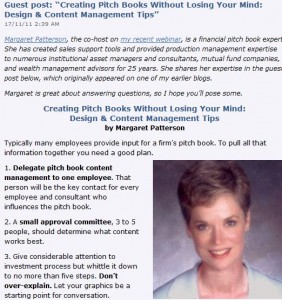I HATE videos. As a lover of the written word, it annoys the heck out of me when people share information only in video or audio. However, there are steps you can take to make video and audio more palatable to cranky folks like me. You’ll find three suggestions below.
Technique 1: Add minute markers
Looking for the easiest, fastest solution? Then, list your video’s major shifts of topic accompanied by the time the shift occurs.
For example, imagine a Q&A on investing in emerging markets. The text accompanying your video might look something like this:
00:00 Introducing Ms. EM Expert
00:30 What are emerging markets?
01:40 Reasons to invest in emerging markets
03:25 Risks of investing in emerging markets
This format lets me figure out what, if anything interests me. Then I can fast-forward to the good stuff.
Technique 2: Summarize the key points
A written summary of your video’s key points will make people like me even happier. However, you’ll find it more time consuming than Technique 1.
Your write-up need not be comprehensive. Just give me the highlights. For example, if we continue to use the emerging markets example, you could give a brief definition of emerging markets, followed by a list of the pros and cons of emerging-markets investing.
Technique 3: Provide a transcript
A transcript — a word-by-word record of your video conversation — is the most time consuming, but it also provides the most information of the three techniques I discuss in this blog post. I like that I can search the transcript for specific words and phrases.
You can make transcripts less time-consuming by outsourcing to a professional transcriptionist. To improve the transcriptionist’s accuracy, provide a list of terms and names that may not be familiar to someone outside your field.
Even with a list of terms, don’t expect your transcript to be perfect. Transcription isn’t easy. Also, human beings don’t speak in perfect sentences. You’ll need to review and edit the transcript word-by-word. This is why I’m not a big fan of publishing transcripts.
If your video features your voice exclusively, you may be able to get it transcribed using voice recognition software. Dragon Naturally Speaking is one option. Again, you’ll need to make corrections.
What’s your favorite?
Of the three options I’ve presented, #1 is my favorite. But I’ll be grateful for whatever you do to help me.
How do YOU make your videos user-friendly?





